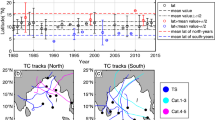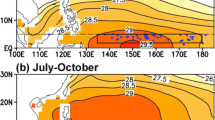Abstract
The genesis of tropical cyclones over the Bay of Bengal region showed a significant amount of both spatial and temporal variability. Mean tropical cyclone genesis locations were shifted southward from July to December. The tropical cyclone activity was greatly suppressed during the monsoon (June–September) season compared to the post-monsoon (October-December) season. A Genesis Potential Index is presented to demonstrate the spatial and temporal alteration in the environmental factors contributing to the tropical cyclone genesis. Here we used six environmental factors such as instability, relative humidity, sea surface temperature, relative vorticity, mean sea level pressure and vertical wind shear. All of the six environmental factors showed a considerable amount of month-wise variability over the Bay of Bengal region from monsoon to post-monsoon season. We observed that during the monsoon season, instability, relative humidity and sea surface temperature were very favorable for tropical cyclone genesis, but the tropical cyclone frequency was very low compared to the post-monsoon season due to very high vertical wind shear and low relative vorticity. On the other hand, reduced vertical wind shear and increased relative vorticity overwhelmed the effect of reduced instability and increased relative humidity and favored tropical cyclone genesis during the post-monsoon season.









Similar content being viewed by others
References
Gray, W. M. (1975). Tropical Cyclone Genesis. Atmospheric Science Paper No. 234. Dept. Atmospheric Science Colorado State University. Fort Collins, Colorado 121 pp.
Molinari, J., & Vollaro, D. (2013). What percentage of western North Pacific tropical cyclones form within the monsoon trough? Monthly Weather Review, 141, 499–505.
Vincent, E. M., et al. (2011). Interannual variability of the South Pacific Convergence Zone and implications for tropical cyclone genesis. Climate Dynamics, 36, 1881–1896.
Wu, L., Wen, Z., Huang, R., & Wu, R. (2012). Possible linkage between the monsoon trough variability and the tropical cyclone activity over the western North Pacific. Monthly Weather Review, 140, 140–150.
Zhou, L., Chen, G., & Wu, R. (2015). Change in surface latent heat flux and its association with tropical cyclone genesis in the western North Pacific. Theor. Appl. Climatol., 119, 221–227.
Huanghfu, J., et al. (2017). Influences of sea surface temperature in the tropical Pacific and Indian Oceans on Tropical cyclone genesis over the western North Pacific in May. Climate Dynamics, 51, 1915–1926.
Huanghfu, J., Chen, W., Ma, T., & Huang, R. (2018). Interdecadal variation of tropical cyclone genesis and its relationship to the convective activities over the Central pacific. Climate Dynamics, 50, 1439–1450.
Kikuchi, K., Wang, B., & Fudeyasu, H. (2009). Genesis of tropical cyclone Nargis revealed by multiple satellite observations. Geophysical Research Letters, 36, L06811.
Lin, I., Chen, C., Pun, I., Liu, W., & Wu, C. (2009). Warm ocean anomaly, air sea fluxes, and rapid intensification of tropical cyclone Nargis (2008). Geophysical Research Letters, 36, L03817.
McPhaden, M. J., et al. (2009). Ocean-atmospheric interactions during cyclone Nargis. EOS, Transactions. American Geo physical Union, 90(7), 53–60.
Yoshida, R., & Ishikawa, H. (2013). Environmental factors contributing to tropical cyclone genesis over the western North Pacific. Monthly Weather Review, 141, 451–467.
Hobgood, J. S. (1986). The influence of relative humidity on the development of tropical cyclones. Physical Geography, 7(4), 283–291.
Hill, K. A., & Lackmann, G. M. (2009). Influence of environmental humidity on tropical cyclone size. Monthly Weather Review, 137, 3294–3315.
Wu, L., et al. (2012). Relationship of environmental relative humidity with North Atlantic tropical cyclone intensity and intensification rate. Geophysical Research Letters, 39, L20809.
Camargo, S. J., Emanuel, K. A., & Sobel, A. H. (2007). Use of a genesis Potential Index to Diagnose ENSO Effects on Tropical Cyclone Genesis. Journal of climate, 20, 4819–4834.
Li, Y., Li, T., Fu, C., & Hsu, P. (2018). Near-equatorial tropical cyclone formation in western North Pacific: peak season and controlling parameter. Climate Dynamics, 52, 2765–2773.
DeMaria, M. (2001). A tropical cyclone genesis parameter for the tropical Atlantic. Weather and Forecasting, 16, 219–233.
Felton, C. S., Subahmanyam, B., & Murty, V. S. N. (2013). ENSO modulated cyclogenesis over the Bay of Bengal. Journal of Climate, 26, 9806–9818.
Girishkumar, M. S., & Ravichandran, M. (2012). The Influences of ENSO on Tropical Cyclone Activity in the Bay of Bengal during October-December. Journal of Geophysical Research, 117, C02033.
Girishkumar, M. S., Thanga Prakash, V. P., & Ravichandran, M. (2015). Influence of pacific decadal oscillation on the relationship between ENSO and tropical cyclone activity in the Bay of Bengal during October-December. Climate Dynamics, 44, 3469–3479.
Mahala, B. K., Nayak, B. K., & Mohanty, P. K. (2015). Impacts of ENSO and IOD on tropical cyclone activity in the Bay of Bengal. Natural Hazards, 75, 1105–1125.
Li, Z., Yu, W., Li, T., Murty, V. S. N., & Tangang, F. (2013). Bimodal Character of cyclone climatology in the Bay of Bengal modulated by monsoon seasonal cycle. Journal of Climate, 26, 1033–1046.
Gatgil, S., & Joseph, P. V. (2003). On breaks of the indian monsoon. Proceedings of the Indian Academy of Sciences, 112(4), 529–558.
Gatgil, S., & Rajeevan, M. (2008). The indian monsoon. Resonance, 13(12), 1117–1132.
Goswami, B. N., Ajayamohan, R. S., Xavier, P. K., & Sengupta, D. (2003). Clustering of synoptic activity by indian summer monsoon interseasonal oscillations. Geophysical Research Letters, 30(8), 1431.
Alam, Md. M., Hossain, Md. A., & Shafee, S. (2003). Frequency of Bay of Bengal cyclonic storms and depressions crossing different coastal zones. International Journal of Climatology, 23, 1119–1125.
Subbaramayya, I., & Rao, S. R. M. (1984). Frequency of Bay of Bengal cyclones in the post-monsoon season. Monthly Weather Review, 112, 1640–1642.
Kikuchi, K., & Wang, B. (2010). Formation of tropical cyclones in the northern indian ocean associated with two types of tropical interseasonal oscillation modes. Journal of the Meteorological Society of Japan, 88(3), 475–496.
Gatgil, S. (2007). The Indian Monsoon. Resonance, 12, 4–20.
Nath, S., Kotal, S. D., & Kundu, P. K. (2013). Analysis of a Genesis Potential Parameter during Pre-Cyclone Watch Period over the Bay of Bengal. Natural Hazards, 65, 2253–2265.
Kotal, S. D., Kundu, P. K., & Roy Bhowmik, S. K. (2009). Analysis of cyclogenesis parameter for developing and nondeveloping low-pressure systems over the indian sea. Natural Hazards, 50, 389–402.
Han, J., Kamber, M., & Pei, J. (2012). Data Mining Concepts and Techniques. Waltham: Morgan Kaufmann.
Dee, D. P., et al. (2011). The ERA-interim reanalysis: configuration and performance of the data assimilation system. Quarterly Journal of the Royal Meteorological Society, 137, 553–597.
Kanamitsu, M., et al. (2002). NCEP-DOE AMIP-II Reanalysis (R-2). Bulletin of the American Meteorological Society, 83(11), 1631–1643.
Palmen, E. (1948). On the Formation and Structure of tropical Hurricanes. Geophysica, 3, 26–38.
Author information
Authors and Affiliations
Corresponding author
Ethics declarations
Conflict of interest
The authors have no conflict of interest.
Additional information
Publisher's Note
Springer Nature remains neutral with regard to jurisdictional claims in published maps and institutional affiliations.
Rights and permissions
About this article
Cite this article
Pal, A., Chatterjee, S. Influence of seasonal variability in the environmental factors on tropical cyclone activity over the Bay of Bengal region. Spat. Inf. Res. 29, 673–684 (2021). https://doi.org/10.1007/s41324-021-00383-9
Received:
Revised:
Accepted:
Published:
Issue Date:
DOI: https://doi.org/10.1007/s41324-021-00383-9




